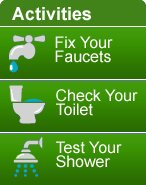The Water Cycle
Nature is always moving water through the air and land, so that the water we use is constantly recycled. The water cycle includes these steps:
Evaporation—The sun heats water in rivers, lakes, and the ocean and turns it into vapor or steam, which then rises into the air.
Condensation—The vapor cools and turns into tiny water droplets that attach to each other and form clouds.
Precipitation—Water falls from the clouds as rain, snow, sleet, or hail.
Runoff—Some water stays on the earth’s surface and flows into rivers, lakes, reservoirs, etc.
Percolation—Other water seeps down into the earth’s natural underground reservoirs called aquifers. Then the cycle begins again, as water from the earth’s surface evaporates into the air.
About 75 percent of the earth’s surface is covered by water, but only 1 percent of this is available for people to use. The rest is salt water or is frozen in polar icecaps and glaciers. Because our water is a limited resource, we must conserve and protect it. |




